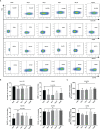Granulocyte Colony-Stimulating Factor Accelerates the Recovery of Hepatitis B Virus-Related Acute-on-Chronic Liver Failure by Promoting M2-Like Transition of Monocytes
- PMID: 35651610
- PMCID: PMC9148949
- DOI: 10.3389/fimmu.2022.885829
Granulocyte Colony-Stimulating Factor Accelerates the Recovery of Hepatitis B Virus-Related Acute-on-Chronic Liver Failure by Promoting M2-Like Transition of Monocytes
Abstract
Background and aim: Acute-on-chronic liver failure (ACLF) has a high mortality rate. The role of granulocyte colony-stimulating factor (G-CSF) in ACLF remains controversial. Monocytes/macrophages are core immune cells, which are involved in the initiation and progression of liver failure; however, the effect of G-CSF on monocytes/macrophages is unclear. The study aimed to verify the clinical efficacy of G-CSF and explore the effect of it on monocytes in hepatitis B virus (HBV)-related ACLF (HBV-ACLF) paitents.
Methods: We performed a large randomized controlled clinical trial for the treatment of HBV-ACLF using G-CSF. A total of 111 patients with HBV-ACLF were prospectively randomized into the G-CSF group (5 μg/kg G-CSF every day for 6 days, then every other day until day 18) or the control group (standard therapy). All participants were followed up for at least 180 days. The relationship between monocyte count and mortality risk was analyzed. The effect of G-CSF on the phenotype and function of monocytes from patients with HBV-ACLF was evaluated using flow cytometry in vivo and in vitro experiments.
Results: The survival probability of the G-CSF group at 180 days was higher than that of the control group (72.2% vs. 53.8%, P = 0.0142). In the G-CSF-treated group, the monocyte counts on days 0 and 7 were independently associated with an evaluated mortality risk in the fully adjusted model (Model 3) [at day 0: hazard ratio (HR) 95% confidence interval (CI): 15.48 (3.60, 66.66), P = 0.0002; at day 7: HR (95% CI): 1.10 (0.50, 2.43), P=0.8080]. Further analysis showed that after treatment with G-CSF in HBV-ACLF patients, the expression of M1-like markers (HLA-DR and CD86) in monocytes decreased (HLA-DR: P = 0.0148; CD86: P = 0.0764). The expression of MerTK (M2-like marker) increased (P = 0.0002). The secretion of TNF-α, IL-6, and IL-10 from monocytes decreased without lipopolysaccharide (LPS) stimulation (TNF-α: P < 0.0001; IL-6: P= 0.0025; IL-10: P = 0.0004) or with LPS stimulation (TNF-α: P = 0.0439; P = 0.0611; IL-10: P = 0.0099). Similar effects were observed in vitro experiments.
Conclusion: G-CSF therapy confers a survival benefit to patients with HBV-ACLF. G-CSF can promote the anti-inflammatory/pro-restorative phenotype (M2-like) transition of monocytes, which may contribute to the recovery of ACLF.Clinical Trial Registration Number: ClinicalTrials.gov, identifier (NCT02331745).
Keywords: acute-on-chronic liver failure; cytokine; granulocyte colony stimulating factor; hepatitis B virus; inflammation; monocytes; prognosis.
Copyright © 2022 Tong, Wang, Xu, Wan, Fang, Chen, Mu, Liu, Chen, Su, Liu, Li, Huang and Hu.
Conflict of interest statement
The authors declare that the research was conducted in the absence of any commercial or financial relationships that could be construed as a potential conflict of interest.
Figures







Similar articles
-
The efficacy and safety of granulocyte colony-stimulating factor in the treatment of acute-on-chronic liver failure: A systematic review and meta-analysis.PLoS One. 2023 Nov 30;18(11):e0294818. doi: 10.1371/journal.pone.0294818. eCollection 2023. PLoS One. 2023. PMID: 38033111 Free PMC article.
-
Granulocyte-colony stimulating factor (G-CSF) to treat acute-on-chronic liver failure: A multicenter randomized trial (GRAFT study).J Hepatol. 2021 Dec;75(6):1346-1354. doi: 10.1016/j.jhep.2021.07.033. Epub 2021 Aug 5. J Hepatol. 2021. PMID: 34364917 Clinical Trial.
-
Therapeutic implications of granulocyte colony stimulating factor in patients with acute-on-chronic liver failure: increased survival and containment of liver damage.Hepatol Int. 2017 Nov;11(6):540-546. doi: 10.1007/s12072-017-9814-1. Epub 2017 Aug 24. Hepatol Int. 2017. PMID: 28840583 Clinical Trial.
-
[Significance of triggering receptor expressed on myeloid cells-2 prognostic evaluation in hepatitis B virus-related acute-on-chronic liver failure].Zhonghua Gan Zang Bing Za Zhi. 2023 Dec 20;31(12):1306-1312. doi: 10.3760/cma.j.cn501113-20230214-00056. Zhonghua Gan Zang Bing Za Zhi. 2023. PMID: 38253075 Chinese.
-
Granulocyte-colony stimulating factor in acute-on-chronic liver failure: Systematic review and meta-analysis of randomized controlled trials.Gastroenterol Hepatol. 2023 May;46(5):350-359. doi: 10.1016/j.gastrohep.2022.09.007. Epub 2022 Sep 27. Gastroenterol Hepatol. 2023. PMID: 36174797 English, Spanish.
Cited by
-
Granulocyte colony-stimulating factor with or without stem or progenitor cell or growth factors infusion for people with compensated or decompensated advanced chronic liver disease.Cochrane Database Syst Rev. 2023 Jun 6;6(6):CD013532. doi: 10.1002/14651858.CD013532.pub2. Cochrane Database Syst Rev. 2023. PMID: 37278488 Free PMC article.
-
Efficacy of Granulocyte Colony-Stimulating Factor in Acute on Chronic Liver Failure: A Systematic Review and Survival Meta-Analysis.J Clin Med. 2023 Oct 16;12(20):6541. doi: 10.3390/jcm12206541. J Clin Med. 2023. PMID: 37892679 Free PMC article. Review.
-
Immunoenhancing of the anti-cancer therapy and anti-oxidative stress by co-administration of granulocyte-colony stimulating factor-mobilized stem cells or cells derived from bone marrow and/or spleen plus vaccination with chemotherapeutic cyclophosphamide.Immunol Res. 2025 Mar 17;73(1):62. doi: 10.1007/s12026-025-09610-z. Immunol Res. 2025. PMID: 40091102
-
The efficacy and safety of granulocyte colony-stimulating factor in the treatment of acute-on-chronic liver failure: A systematic review and meta-analysis.PLoS One. 2023 Nov 30;18(11):e0294818. doi: 10.1371/journal.pone.0294818. eCollection 2023. PLoS One. 2023. PMID: 38033111 Free PMC article.
-
Plasma interleukin-7 correlation with human immunodeficiency virus RNA and CD4+ T cell counts, and interleukin-5 with circulating hepatitis B virus DNA may have implications in viral control.Front Med (Lausanne). 2022 Nov 3;9:1019230. doi: 10.3389/fmed.2022.1019230. eCollection 2022. Front Med (Lausanne). 2022. PMID: 36405584 Free PMC article.
References
-
- Sarin SK, Choudhury A, Sharma MK, Maiwall R, Al Mahtab M, Rahman S, et al. . Acute–on–Chronic Liver Failure: Consensus Recommendations of the Asian Pacific Association for the Study of the Liver (APASL): An Update. Hepatol Int (2019) 13(4):353–90. doi: 10.1007/s12072-019-09946-3 - DOI - PMC - PubMed
Publication types
MeSH terms
Substances
Associated data
LinkOut - more resources
Full Text Sources
Medical
Research Materials
Miscellaneous

